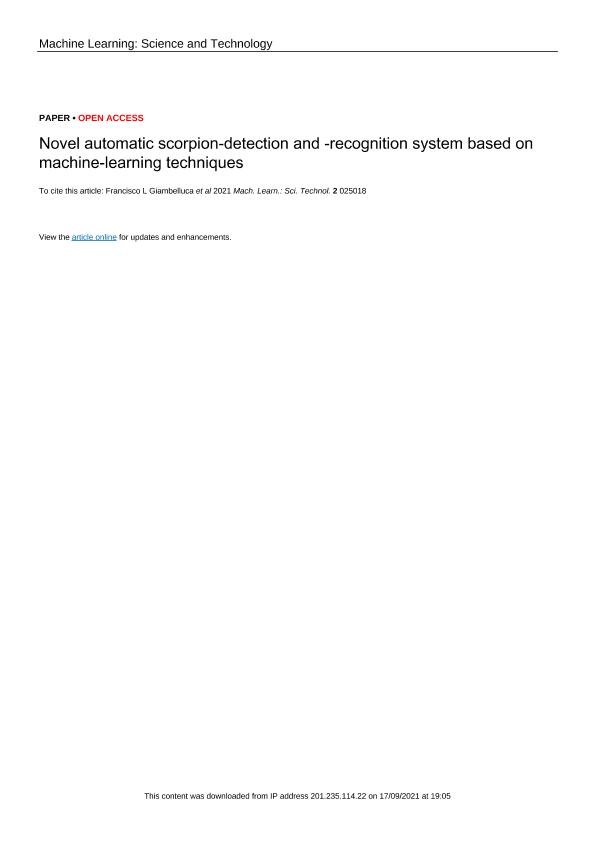Mostrar el registro sencillo del ítem
dc.contributor.author
Giambelluca, Francisco Luis

dc.contributor.author
Cappelletti, Marcelo Ángel

dc.contributor.author
Osio, Jorge
dc.contributor.author
Giambelluca, Luis Alberto

dc.date.available
2021-09-17T18:11:12Z
dc.date.issued
2020-12
dc.identifier.citation
Giambelluca, Francisco Luis; Cappelletti, Marcelo Ángel; Osio, Jorge; Giambelluca, Luis Alberto; Novel automatic scorpion-detection and -recognition system based on machine-learning techniques; IOP Publishing; Machine Learning: Science and Technology; 2; 12-2020; 1-16
dc.identifier.issn
2632-2153
dc.identifier.uri
http://hdl.handle.net/11336/140751
dc.description.abstract
All species of scorpions have the ability to inoculate venom, some of them even with the possibility of killing a human. Therefore, early detection and identification is essential to minimize scorpion stings. In this paper, we propose a novel automatic system for the detection and recognition of scorpions using computer vision and machine learning approaches. Two complementary image processing techniques were used for the proposed detection method in order to accurately and reliably detect the presence of scorpions. The first based on the fluorescence characteristics of scorpions when are exposed to ultraviolet (UV) light, and the second on the shape features of the scorpions. On the other hand, three models based on machine learning algorithms for the image recognition and classification of scorpions have been compared. In particular, the three species of scorpions found in La Plata city (Argentina): Bothriurus bonariensis (of no sanitary importance), and Tityus trivittatus and Tityus confluence (both of sanitary importance), have been researched using the Local Binary Pattern Histogram (LBPH) algorithm and deep neural networks with transfer learning (DNN with TL) and data augmentation (DNN with TL and DA) approaches. Confusion matrix and Receiver Operating Characteristic (ROC) curve were used for evaluating the quality of these models. Results obtained show that the DNN with TL and DA model is the most efficient model to simultaneously differentiate between Tityus and Bothriurus (for health security) and between Tityus trivittatus and Tityus confluence (for biological research purposes).
dc.format
application/pdf
dc.language.iso
eng
dc.publisher
IOP Publishing

dc.rights
info:eu-repo/semantics/openAccess
dc.rights.uri
https://creativecommons.org/licenses/by/2.5/ar/
dc.subject
DATA AUGMENTATION
dc.subject
LOCAL BINARY PATTERN
dc.subject
MACHINE LEARNING
dc.subject
SCORPION IMAGE CLASSIFICATION
dc.subject
TRANSFER LEARNING
dc.subject.classification
Ingeniería Eléctrica y Electrónica

dc.subject.classification
Ingeniería Eléctrica, Ingeniería Electrónica e Ingeniería de la Información

dc.subject.classification
INGENIERÍAS Y TECNOLOGÍAS

dc.title
Novel automatic scorpion-detection and -recognition system based on machine-learning techniques
dc.type
info:eu-repo/semantics/article
dc.type
info:ar-repo/semantics/artículo
dc.type
info:eu-repo/semantics/publishedVersion
dc.date.updated
2021-09-06T17:20:48Z
dc.journal.volume
2
dc.journal.pagination
1-16
dc.journal.pais
Reino Unido

dc.journal.ciudad
Bristol
dc.description.fil
Fil: Giambelluca, Francisco Luis. Consejo Nacional de Investigaciones Científicas y Técnicas. Centro Científico Tecnológico Conicet - La Plata. Instituto de Investigaciones en Electrónica, Control y Procesamiento de Señales. Universidad Nacional de La Plata. Instituto de Investigaciones en Electrónica, Control y Procesamiento de Señales; Argentina
dc.description.fil
Fil: Cappelletti, Marcelo Ángel. Consejo Nacional de Investigaciones Científicas y Técnicas. Centro Científico Tecnológico Conicet - La Plata. Instituto de Investigaciones en Electrónica, Control y Procesamiento de Señales. Universidad Nacional de La Plata. Instituto de Investigaciones en Electrónica, Control y Procesamiento de Señales; Argentina. Universidad Nacional Arturo Jauretche; Argentina
dc.description.fil
Fil: Osio, Jorge. Universidad Nacional Arturo Jauretche; Argentina. Consejo Nacional de Investigaciones Científicas y Técnicas. Centro Científico Tecnológico Conicet - La Plata. Instituto de Investigaciones en Electrónica, Control y Procesamiento de Señales. Universidad Nacional de La Plata. Instituto de Investigaciones en Electrónica, Control y Procesamiento de Señales; Argentina
dc.description.fil
Fil: Giambelluca, Luis Alberto. Consejo Nacional de Investigaciones Científicas y Técnicas. Centro Científico Tecnológico Conicet - La Plata. Centro de Estudios Parasitológicos y de Vectores. Universidad Nacional de La Plata. Facultad de Ciencias Naturales y Museo. Centro de Estudios Parasitológicos y de Vectores; Argentina
dc.journal.title
Machine Learning: Science and Technology
dc.relation.alternativeid
info:eu-repo/semantics/altIdentifier/url/https://iopscience.iop.org/article/10.1088/2632-2153/abd51d
dc.relation.alternativeid
info:eu-repo/semantics/altIdentifier/doi/http://dx.doi.org/10.1088/2632-2153/abd51d
Archivos asociados
